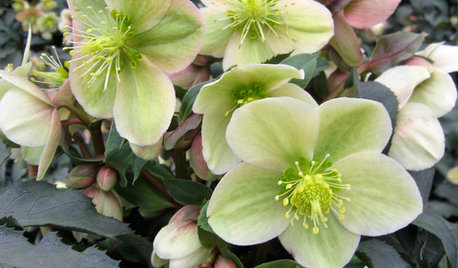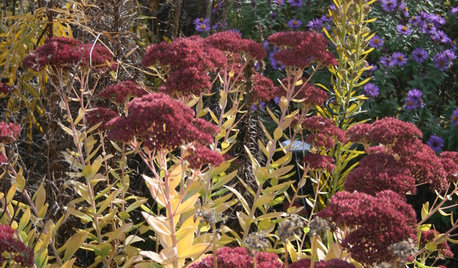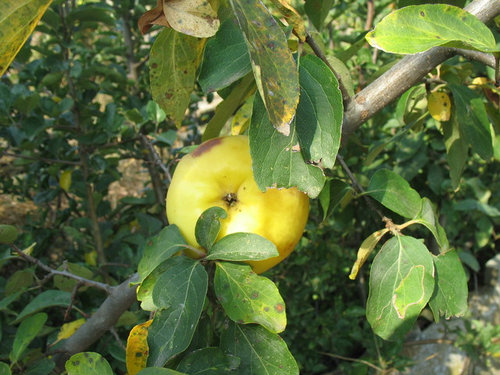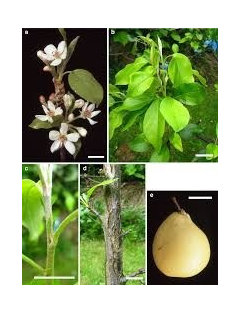hybrid between quince and apple
parker25mv
8 years ago
last modified: 8 years ago
Featured Answer
Sort by:Oldest
Comments (6)
parker25mv
8 years agolast modified: 8 years agoparker25mv
8 years agolast modified: 8 years agoRelated Discussions
Grafting asian pear onto medlar or quince
Comments (4)I know they graft European pears onto quince, because that is what my Bosc is clearly grafted on. Definitely quince foliage from the persistent suckers that emerge at or near ground level. I would think Asian pear would work as well on quince. I was never very successful getting a decent crop of quinces until last year and especially this year when I found out about the Triazicide Once and Done from this forum. I grew nearly perfect, worm free quinces this year. A couple of coddling moths in a handful of the cores, but just a few, but, I slacked off spraying after about late July. Had I done just one early-mid-August spray, they probably would have been pristine. Not complaining, I got way too many as it was....See MoreHow did I miss Quinces and Persimmons?
Comments (6)How about Asian persimmons (Fuyu and such)? They are even better, but a little different, than American persimmons. I would kill to be able to really grow them here. I'm experimenting, but long term they won't make it due to weather. Really, there are all kinds of unusual fruits out there that many people haven't tried. If I lived in Zone 7, I'd be experimenting with things like Butia capitata, the Chilean Jelly Palm, with various hardy types of pomegranates, with the various Citranges, which are hybrids of regular citrus and the hardy Poncirus trifoliata, with figs, with Pineapple Guavas. I do have a question about your quince -- 1" and brown doesn't sound like any quince I know, even the flowering quinces -- those generally have a 2 to 4 inch diameter fruit with is kind of an orange color when ripe. I am wondering if what you sampled isn't a quince, but is perhaps a Medlar, which is related to quince, but has roughly 1 to 2 inch, brown fruits that aren't eaten until fully softened (called "bletted") and are said to taste like applesauce with cinnamon?...See More(OT) Quince
Comments (27)I don't know the name(s) of ours; they were bought at different times but look like they're all the same kind. They could be the variety you describe: the fruit corresponds, but I haven't seen our trees getting big, though one will have to pruned lower this year. I don't know if they've just grown slowly (no water or fertilizer) or if they naturally stay the size of a large shrub. They seem to want to develop a shrubby habit. Ours fruited heavily this year. Up to this year we've left most of the fruit on the tree. On the other hand I've never had our soil tested for its mineral content. The clay, once adequately amended with organic matter, seems to be good for a lot of plants. I take note of your comments about potassium. N.B. we had just the first tree for a while and it did fruit, so I take it it's not a self-sterile kind. By the way, you mentioned in another thread that the during the process of decomposition organic matter in the soil will consume nitrogen, making it desirable to add nitrogen for the plants growing there. Does it make a difference if the organic matter was collected while still alive (hay, pruned live twigs and canes) or had died (dead leaves and organic detritus)? Seems I read something about this once....See MoreThoughts on breeding new varieties of Quince for eating off the tree
Comments (7)As for how my quince trees are doing, see this other related thread: [Crimea quince fruit review[(https://www.houzz.com/discussions/crimea-quince-fruit-review-dsvw-vd~5476273) Kuganskaya is pretty good eating quality, and no doubt if it was crossed with a pear it would lead to something completely edible out of hand. Virtually almost like a Granny Smith Apple but much more acidic. Astringency virtually isn't noticeable in just one or two small slices. Karp's Sweet is still alive and very slowly growing, but it's in a different climate (zone 10 ) so isn't growing as fast as the other quinces. It did set just a few blossoms though last year. It's late December and the tree still has green leaves which have not dropped. I don't really feel that the waxy peel and fuzz are impediments to out of hand eating, so not really concerned about that. (In any case, these "edible" quinces don't really have as much waxy fuzz as the other normal ones)...See Morefrancis_eric
8 years agoparker25mv
7 years agolast modified: 7 years agoOdin Arsa
11 months ago
Related Stories

EDIBLE GARDENSWhy Grow Quince? For Beauty, Fragrance and Old-Time Flavor
Delightfully perfumed fruit and lovely spring blossoms make this apple and pear cousin worth a spot in the garden
Full Story
EDIBLE GARDENSHow to Add an Apple Tree to Your Edible Garden
Readily available, beautiful and fragrant, apple trees offer four-season interest along with crisp, juicy fruit
Full Story
WINTER GARDENINGGreat Design Plant: Gold Collection Hellebores Perform Like Stars
Exciting colors, longer bloom times, forward-facing flowers ... These hybrids leave old hellebores in the dust
Full Story
DECORATING GUIDESThinking Spring: Blossoming Branches
Cherry, Peach and Apple Flowers Make Interiors Bloom
Full Story
EDIBLE GARDENSHow to Grow 10 Favorite Fruit Trees at Home
Plant a mini orchard in fall, winter or early spring to enjoy fresh-off-the-tree fruit the following year
Full Story
EDIBLE GARDENSHow to Grow Your Own European and Asian Pears
Try these trees for their good looks, delicious fruit and wide range of sizes — plus you can espalier them
Full Story
FRUIT TREESHow to Grow Your Own Persimmons
Sturdy and easy to care for, these trees offer bright fruit through winter — and keeping them in bounds is no sweat
Full Story
FRUIT TREESHow to Grow Your Own Juicy Plums
Easier than other stone fruits and with a variety of colors to choose from, plums are a versatile garden addition
Full Story
GARDENING GUIDES8 Plants for a Deliciously Fragrant Fall Garden
Scent the autumn air with the perfume of caramel corn, honey and spices by adding these intoxicating plants to your landscape
Full Story
GARDENING GUIDES8 Perennials for Great Fall Color
Trees haven't cornered the market on autumn splendor. Add these flowering perennials for a foliage sight to behold
Full StorySponsored
Columbus Design-Build, Kitchen & Bath Remodeling, Historic Renovations
More Discussions





Володимир Меженський